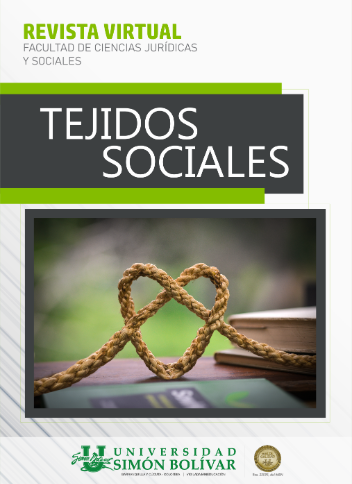Relaciones Parasociales en Jóvenes Universitarios de la Ciudad de Barranquilla
Contenido principal de artículos
Palabras clave:
conexión emocional, figuras mediática, redes sociales, relaciones parasociales, vinculo
Resumen
Objetivo: Describir la intensidad de las relaciones parasociales en los jóvenes universitarios de la ciudad de Barranquilla. Métodos y materiales: Se aplicó una encuesta en la plataforma de Microsoft Forms, en la cual se utilizaron la escala MMPR y la escala PRISM que facilitaron la evaluación de dimensiones como la afectiva, cognitiva, conductual, decisiva, de interés, conocimiento, identificación e interacción pertenecientes a las relaciones parasociales de 323 estudiantes universitarios entre los 18 años y los 28 años, por medio de una investigación de carácter descriptivo. Resultados: Se halló un nivel alto de relaciones parasociales con un 46,1 % en la escala de MMPR, adicionalmente se presentó un 46,4% de nival alto en la dimensión afectiva perteneciente en esta escala. En la escala PRIMS se encontró que un 49,5% presenta una relación parasocial en las redes sociales y la dimensión de interés reflejó la media más alta con un 21,9 con relación a las otras dimensiones de esta escala. Discusión: Los resultados de este estudio ofrecen una comprensión detallada de las relaciones parasociales en jóvenes universitarios de Barranquilla, destacando la importancia de distintas dimensiones en la configuración de estos vínculos. Conclusiones: Estas dimensiones no solo demuestran el impacto significativo que las figuras mediáticas tienen sobre estos jóvenes en términos emocionales y cognitivos, sino que también indican que estas relaciones pueden funcionar como una forma de compensación en un entorno social donde la conexión real puede ser limitada. La fuerte conexión emocional y la identificación con figuras mediáticas reflejan una búsqueda de conexión y pertenencia, que con frecuencia no está presente en la vida diaria de los jóvenes.
Citas
Boyd, A. T., Morrow, J. A., & Rocconi, L. M. (2022). Development and Validation of the Parasocial Relationship in Social Media Survey. The Journal of Social Media in Society, 11(2), 192-208. https://www.thejsms.org/index.php/JSMS/article/view/1085
Cohen, E. L., Myrick, J. G., & Hoffner, C. A. (2021). Effects of Celebrity Silence Breakers: Liking and Parasocial Relationship Strength Interact to Predict the Social Influence of Celebrities’ Sexual Harassment Allegations. Mass Communication & Society, 24(2), 288–313. https://doi.org/10.1080/15205436.2020.1839102
Degen, J. L. (2023). Rationalizing Fiction Cues: Psychological Effects of Disclosing Ads and the Inaccuracy of the Human Mind When Being in Parasocial Relationships. Informing Science, 26, 85–101. https://doi.org/10.28945/5108
Garcia, D., Björk, E., & Kazemitabar, M. (2022). The A(ffect) B(ehavior) C(ognition) D(ecision) of parasocial relationships: A pilot study on the psychometric properties of the Multidimensional Measure of Parasocial Relationships (MMPR). Heliyon, 8(10). https://doi.org/10.1016/j.heliyon.2022.e10779
Giles, D. (2002). Parasocial interaction: A review of the literature and a model for future research. Media Psychology, 4(3), 279-305. https://doi.org/10.1207/S1532785XMEP0403_04
Horton, D., & Wohl, R. R. (1956). Mass Communication and ParaSocial Interaction. Psychiatry, 19(3), 215–229. https://doi.org/10.1080/00332747.1956.11023049
Juntiwasarakij, S. (2018). Framing emerging behaviors influenced by internet celebrity. Kasetsart Journal of Social Sciences, 39(3), 550-555. https://doi.org/10.1016/j.kjss.2018.06.014
Lou, C., & Kim, H. K. (2019). Fancying the New Rich and Famous? Explicating the Roles of Influencer Content, Credibility, and Parental Mediation in Adolescents’ Parasocial Relationship, Materialism, and Purchase Intentions. Frontiers in Psychology, 10. https://doi.org/10.3389/fpsyg.2019.02567
Mikulincer, M. & Shaver, P. (2007). Attachment in adulthood: Structure, dynamics, and change. The Guilford Press.
Rungruangjit, W. (2022). What drives Taobao live streaming commerce? The role of parasocial relationships, congruence and source credibility in Chinese consumers’ purchase intentions. Heliyon, 8(6), 2-16. https://doi.org/10.1016/j.heliyon.2022.e09676
Scherer, H., Diaz, S., Iannone, N., McCarty, M., Branch, S., & Kelly, J. (2022). “Leave Britney alone!”: parasocial relationships and empathy. Journal of Social Psychology, 162(1), 128–142. https://doi.org/10.1080/00224545.2021.1997889
Tsay-Vogel, M., & Schwartz, M. L. (2014). Theorizing parasocial interactions based on authenticity: The development of a media figure classification scheme. Psychology of Popular Media Culture, 3(2), 66–78. https://doi.org/10.1037/a0034615
Yudha, A. (2023). A Source Effect Theory Perspective on How Opinion Leadership, Parasocial Relationship, and Credibility Influencers Affect Purchase Intention. Jurnal Manajemen Teori Dan Terapan, 16(2), 240–253. https://doi.org/10.20473/jmtt.v16i2.48099
Zsila, Á., Orosz, G., McCutcheon, L. E., & Demetrovics, Z. (2020). A lethal imitation game? Exploring links among psychoactive substance use, self-harming behaviors and celebrity worship. Addictive Behaviors Reports, 12. https://doi.org/10.1016/j.abrep.2020.100319

